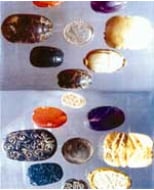According to a report in the Egyptian daily Al-Ahram, by Wajih Al-Saqqar, archeologists have discovered ancient Egyptian coins bearing the name and image of the Biblical Joseph.
Following are excerpts from the article: [1]

"Koranic Verses Indicate Clearly That Coins Were Used in Egypt in the Time of Joseph"
"In an unprecedented find, a group of Egyptian researchers and archeologists has discovered a cache of coins from the time of the Pharaohs. Its importance lies in the fact that it provides decisive scientific evidence disproving the claim by some historians that the ancient Egyptians were unfamiliar with coins and conducted their trade through barter.
"The researchers discovered the coins when they sifted through thousands of small archeological artifacts stored in [the vaults of] the Museum of Egypt. [Initially] they took them for charms, but a thorough examination revealed that the coins bore the year in which they were minted and their value, or effigies of the pharaohs [who ruled] at the time of their minting. Some of the coins are from the time when Joseph lived in Egypt, and bear his name and portrait.
"There used to be a misconception that trade [in Ancient Egypt] was conducted through barter, and that Egyptian wheat, for example, was traded for other goods. But surprisingly, Koranic verses indicate clearly that coins were used in Egypt in the time of Joseph.
"Research team head Dr. Sa'id Muhammad Thabet said that during his archeological research on the Prophet Joseph, he had discovered in the vaults of the [Egyptian] Antiquities Authority and of the National Museum many charms from various eras before and after the period of Joseph, including one that bore his effigy as the minister of the treasury in the Egyptian pharaoh's court…
"Dr. Sa'id Thabet added that he had examined the sarcophagi of many pharaohs in search of coins used as charms or ornaments, and that he had indeed found such ancient Egyptian coins. This [find] prompted researchers to seek and find Koranic verses that speak of coins used in ancient Egypt, [such as]: 'And they sold him [i.e. Joseph] for a low price, a number of silver coins; and they attached no value to him. [Koran 12:20].' [Also,] Qarun [2] says about his money: 'This has been given to me because of a certain knowledge which I have [Koran 28: 78].'"
"Studies... Have Revealed That What Most Archeologists Took For a Kind of Charm, and Others Took For an Ornament... is Actually a Coin"
"According to Dr. Thabet, his studies are based on publications about the Third Dynasty, one of which states that the Egyptian coin of the time was called a deben and was worth one-fourth of a gram of gold. This coin is mentioned in a letter by a man named Thot-Nehet, a royal inspector of the Nile bridges. In letters to his son, he mentioned leasing lands in return for deben-coins and agricultural produce.
"Other texts from the time of the Third Dynasty, the Sixth Dynasty and the Twelfth Dynasty mention a coin named shati or sat, whose value was equal to that of the deben. There is also a picture of an Egyptian market showing trade being conducted through barter, but one of the vendors puts out his hand, asking the buyer for a deben in return for the goods.
"Studies by Dr. Thabet's team have revealed that what most archeologists took for a kind of charm, and others took for an ornament or adornment, is actually a coin. Several [facts led them to this conclusion]: first, [the fact that] many such coins have been found at various [archeological sites], and also [the fact that] they are round or oval in shape, and have two faces: one with an inscription, called the inscribed face, and one with an image, called the engraved face - just like the coins we use today.
"The archeological finding is also based on the fact that the inscribed face bore the name of Egypt, a date, and a value, while the engraved face bore the name and image of one of the ancient Egyptian pharaohs or gods, or else a symbol connected with these. Another telling fact is that the coins come in different sizes and are made of different materials, including ivory, precious stones, copper, silver, gold, etc."
"500 of These Coins Were [Recently] Discovered in the Museum of Egypt - Where They Were [Originally] Classified as Charms and Stored Carelessly in Closed Boxes"
"The researcher also pointed out that the coins made of precious metals or stones usually had a hole in them, like a woman's ornament, allowing them to be [worn] around the neck or on the chest. Some of them, which bore images of gods and texts from various prayers or incantations, were treasured belongings that were placed into the bindings of mummies or placed [on the chest, close to] the heart. The coins were scarab-shaped. What made the discovery possible was the fact that 500 of these coins were [recently] discovered in the Museum of Egypt, where they were [originally] classified as charms and stored carelessly in closed boxes."
"One Coin... [Had] an Image of a Cow Symbolizing Pharaoh's Dream about the Seven Fat Cows and Seven Lean Cows"
"The researcher identified coins from many different periods, including coins that bore special markings identifying them as being from the era of Joseph. Among these, there was one coin that had an inscription on it, and an image of a cow symbolizing Pharaoh's dream about the seven fat cows and seven lean cows, and the seven green stalks of grain and seven dry stalks of grain. It was found that the inscriptions of this early period were usually simple, since writing was still in its early stages, and consequently there was difficulty in deciphering the writing on these coins. But the research team [managed to] translate [the writing on the coin] by comparing it to the earliest known hieroglyphic texts…
"Joseph's name appears twice on this coin, written in hieroglyphs: once the original name, Joseph, and once his Egyptian name, Saba Sabani, which was given to him by Pharaoh when he became treasurer. There is also an image of Joseph, who was part of the Egyptian administration at the time.
"Dr. Sa'id Thabet called on Egypt's Antiquities Council and on the Minister of Culture to intensify efforts in the fields of Ancient Egyptian history and archeology, and to [promote] the research of these coins that bear the name of Egyptian pharaohs and gods. This, he said, would enable the correction of prevalent misconceptions regarding the history of Ancient Egypt."
Endnotes:
[1] Al-Ahram (Egypt), September 22, 2009.
[2] This is the Koranic name of Biblical Korah.




